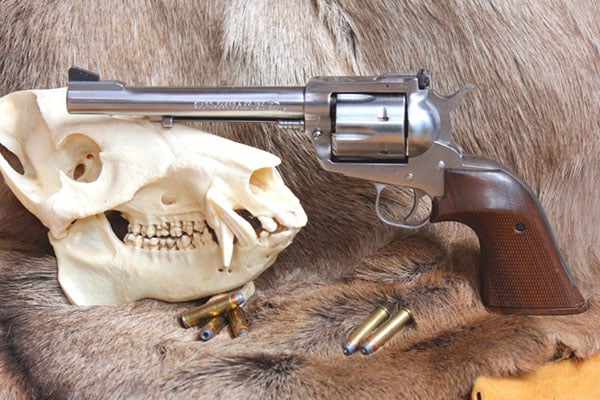
Last Updated on
-By Tony Martins-
The Ruger Blackhawk Single-Action Revolver has been in continuous production for 60 years. Though not without a few changes along the way, this is nonetheless a remarkable record for this venerable six-shooter. Trying to come up with another product from the mid-1950’s in the durable goods category that even approaches the track record of the Blackhawk would result in mental exhaustion. Yet this firearm was engineered and manufactured so well that demand for vintage original “Flattop” and “3-Screw” models, as well as the “New Model” and current line extensions, is as great today as ever before. Consider that this firearm is used primarily in recreation and sporting activities, so notwithstanding sidearm duty for some rural western lawmen, it’s participation in the enormous market for Military and Police arms has been miniscule. Truly remarkable.
With so much history, reviewing a product that’s been around for 60 years – and nearly 40 years in its current model – should be comparatively easy, and I eagerly accepted this assignment. Taking a new and/or different approach to reviewing the Ruger Blackhawk however, presents a genuine challenge. Fortunately, a wealth of adjectives have been used to describe this single-action (SA) revolver over the years – like “venerable” and “remarkable” used above – so the approach here will be to review the descriptive words that readily pop into the minds of those who know the Blackhawk, and then discuss the significance of each for today’s prospective buyer. A proper review of the Ruger Blackhawk however, would be incomplete without a few words about the man who designed the gun, and some history of the company that bears his name.
In 1949 William B. Ruger partnered with young firearms enthusiast Alexander Sturm to start the Sturm, Ruger & Company, Inc. With a $50,000 start-up loan from Sturm’s family, they rented a small machine shop in Southport, Connecticut to produce the .22 Ruger Standard. A year later the semi-automatic pistol was ready for sale and proved to be an instant success with the masses, due to its aesthetic appeal and comparatively low cost, as well as its accuracy and reliability. Profitable in its first year, the company quickly paid back the loan from the Sturm family, and has neither lost nor borrowed money since – operating solely on revenues generated. After Alex Sturm’s death from viral hepatitis in 1951, Bill Ruger assumed control of the company and started work on his next offering. He has been called a visionary for his ability to read the firearms market like he had a crystal ball, and this insight lead to development of the Ruger Single-Six in 1953. Noting the popularity of Western movies, and the fact that Colt had ceased production of the Single-Action Army revolver after World War II, Ruger saw the void as a market opportunity. While other manufacturers thought the single-action revolver was dead, Ruger’s Single-Six .22 rimfire was embraced by anxious buyers and soon became as successful as his .22 Standard. Expanding on a winning theme, he went on to develop the most extensive line of single-action revolvers in history – starting with the .357 Magnum Blackhawk in 1955. To this day, demand for single-action revolvers remains high, and the company has grown into one of the largest and most versatile manufacturers of firearms in the United States, with offerings in all four major market segments – shotguns, rifles, pistols and revolvers. Bill Ruger passed away in July, 2002. He will surely be remembered as the greatest firearms designer of our time, not so much for invention, but more for refinement and improvement of older designs and improved manufacturing techniques like precision investment casting, that produced better, stronger products. I expect that someday he will stand in history with firearms legends like Sam Colt and the incomparable John Moses Browning.
Old Flattop, 3-Screw and New Model Blackhawks
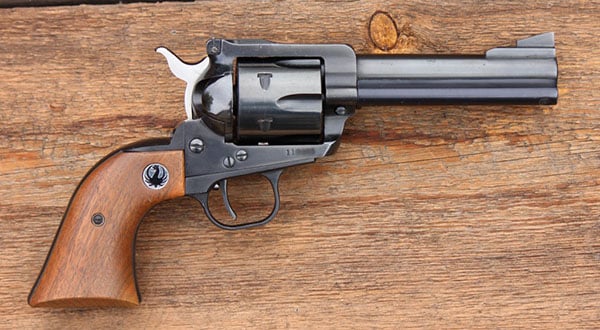
The original .357 Magnum Ruger Blackhawk was designed to look and feel like a Colt Single-Action Army revolver, but with modern improvements. These included an adjustable rear sight and sturdy coil springs for hammer and trigger instead of the traditional but weaker flat ones that were prone to fatigue and failure. Like the Colt, the Blackhawk frame had a flat top strap, and the lock work was so similar that the Blackhawk carried three screws on the side of the frame, just like the Colt. In 1956 Remington developed the .44 Magnum cartridge, working closely with Smith & Wesson to create the Model 29. A popular legend holds that Bill Ruger created his own .44 Rem. Mag revolver from a few empty casings, and may have even beat S&W to the open market with the new .44 Mag Blackhawk in the fall of that year. This hand canon was built on a larger frame to handle the greater pressure of this powerful cartridge. The company now made SA revolvers in three different frame sizes – the Single-Six (small), the .357 BH (medium) and the .44 BH (large). In 1959 the Super Blackhawk in .44 Mag was born with “ears” to protect the adjustable rear sight, a longer dragoon style grip frame, and 7-1/2-inch barrel. It was intended to be an improvement over the .44 Mag “flattop,” particularly for hunters. Starting in 1962 the protective ears were added to all Blackhawk top straps, ending the run of the flattop, and in 1963 the non-Super .44 Mag Blackhawk was discontinued. The Blackhawks were completely redesigned in 1973, both inside and out. Inside, a new lock was fitted and a transfer bar safety was added, making the gun safe to carry with six rounds in the cylinder. With the loading gate now regulating the cylinder for loading, the hammer no longer had the familiar four clicks of the previous Blackhawks and the Colts. The new innards required only two screws (actually pins) on the side of the frame, so the “3-screw” bit the dust. Outside, the big news was a change in frame size. Gone was the medium-sized frame – from 1973 onward, all “New Model” Blackhawks as the gun was renamed, were to be built on the larger .44 Mag sized frame, regardless of caliber.
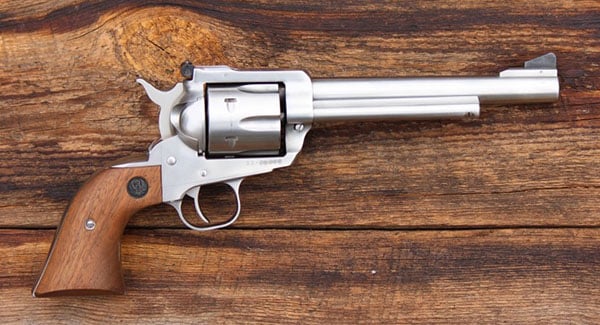
While the .44 Mag Super Blackhawk was lauded as one of the all-time classic single-actions, a favorite preferred by handgun hunters, and one of the top handgun bargains of all time, the New Model .357 Mag Blackhawk was not as well received. Many lamented the loss of the medium framed revolver, thought to be gone forever. Recognizing the growing popularity of Cowboy Action Shooting, and the demand for medium framed .45 Colts and .357 Mags for single-action competition, Ruger introduced the New Vaquero in 2005. The medium frame and smaller grip size of the old 3-screw Blackhawks and Colt Single Actions was revived, but these new revolvers lacked the Blackhawk’s adjustable rear sights. A few months later, to commemorate the 50th anniversary of the Blackhawk, Ruger released a .357 Mag New Model Blackhawk built on the medium frame with flat top strap and adjustable sights. This gun was produced in a special limited run, and today all .357 Mag Blackhawks are again produced on the large frame only – along with .41 Rem. Mag, .44 Special, .45 Colt and .30 Carbine caliber models, as well as “convertible” models with two interchangeable cylinders (.357 Mag/9mm Luger and .45 Colt/.45 Auto). And, the New Model Super Blackhawk continues with several offerings including the Bisley Hunter, all in .44 Rem. Mag.
Complimentary Adjectives
Stylish
Describing any of the Ruger Blackhawks as stylish will arouse few objections. From the original medium framed models to the large framed New Models and Supers, all Blackhawks have a classic look that embodies the Spirit of the Old West. These revolvers give us the opportunity to own and enjoy a Colt-like six-shooter, with modern features like excellent micro-adjustable sights and safety afforded by the transfer bar, without having to pay the price for an original Colt Peacemaker. And, its 60+ year production run – during which well over 2 million have been manufactured – certainly validates a common reference to the Ruger Blackhawk as a timeless classic.
Affordable
Ruger Blackhawks are typically priced lower than lesser imported copies of the Colt Single-Action. This establishes the current Blackhawk as a genuine American-made value. Simple is an adjective that is often uncomplimentary – but simplicity is one of the characteristics that keeps demand for the Blackhawk high. Often repeated is an accolade that is closely related to its simplicity: “The Blackhawk points so well that sights are unnecessary.” It’s easy to shoot, easy to shoot accurately and thus by extension, it’s also easy to control – particularly for the inexperienced sixgunner. For any handgun to be accurate it must be controllable, and Blackhawks are both. Furthermore, its simple design makes the Blackhawk one of the easiest revolvers to maintain. You don’t need a bag full of specialized gunsmithing tools to take it apart for thorough cleaning, in fact to field strip the Blackhawk you don’t need any tools at all. Simply open the loading gate, push in the cylinder latch and pull the cylinder pin forward. The cylinder will now easily drop out of the frame for cleaning and oiling.
Dependable
So what do you call a single-action revolver that never malfunctions or breaks? You call it a Ruger Blackhawk. The strength afforded by precision investment cast parts make the brilliantly engineered, over-built New Model Blackhawk one of the most reliable handguns ever made. My stainless .357 pictured here was manufactured in 1976, and despite digesting thousands (and thousands) of rounds over the past 39 years, it functions today just like it did the day it left the factory. In all this time, I have yet to find a single round of any type, whether .357 Mag or .38 Special, that this gun does not like. And, you can purchase a new one just like it today!
Durable
If the prospect of a gun that you purchase outliving both you and your grandchildren is appealing to you, consider the New Model Blackhawk. They are not indestructible, but with a little TLC and some occasional maintenance, this gun will last forever. Tough and rugged like those hardy soles who settled the Wild West, the Super Blackhawk is right at home with today’s modern explorers and adventurers, providing sidearm protection in the wildest and most extreme environments on Earth. Hunters carry the Super Blackhawk as a primary or secondary weapon with confidence, knowing it will not let them down, rain or shine, wet dry or frozen, through decades of service. Honestly, the durability of the New Model Blackhawk makes the old Timex watch torture testing (you know… “It takes a licking and keeps on ticking”) look silly by comparison.
Strong
This might sound like an odd adjective for a handgun, but extraordinarily strong construction is what makes the Blackhawk so durable, as well as safe to shoot. It’s often said that Blackhawks are built like a vault or a tank – so strong that they are the undisputed king of revolvers when it comes to high pressure handloads, particularly in the .45 Colt caliber. Reloading manuals often have a special section listing high pressure loads that are designed for use in Ruger Blackhawk revolvers and Thompson-Center Arms Contender single shot pistols, only. This doesn’t mean that you cannot blow up a Blackhawk, however. It simply means that Blackhawks are built strong enough to provide a greater margin of safety than other revolvers. And, safety is the reason that Bill Ruger redesigned the already over-built Blackhawk in 1973, creating the New Model. In addition to the beefed-up frame, its new guts featured a transfer bar firing system which allowed the gun to be carried safely with all six chambers loaded. Like the Colt Single-Action, it was necessary to carry the older Blackhawks with an empty chamber under the hammer to prevent accidental discharge. Unfortunately, more than one idiot failed to read the owner’s manual. With the New Model, as the hammer is slowly lowered the transfer bar falls, preventing the hammer from making contact with the firing pin. Though no fault of the gun or the company that manufactured it, improper loading and handling of “old model” Blackhawks by careless individuals resulted in accidental injuries. As the success of Sturm, Ruger & Co. grew in the late 1960’s and early 1970’s predatory tort lawyers took notice, filing unfair (and expensive to fight) lawsuits against the company on behalf of their greedy, irresponsible clients. In an effort to derail this runaway train, Bill Ruger created the New Model Blackhawk, which is likely the safest revolver ever made.
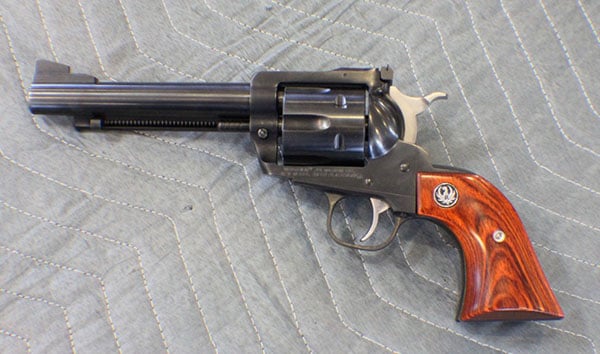
Versatile
Considering all the great attributes of the Ruger Blackhawk, the one that sets it apart from the rest for me is its versatility. At the turn of the 20th century, the Colt Single-Action Army was the one handgun that could do it all – today, it’s the Blackhawk. There are 8 different calibers (noted above) including convertible models, and 5 different barrel lengths (4-5/8” 5-1/2” 6-1/2” 7-1/2” and 10-1/2”) currently available in the Blackhawk lineup – enough choices to cover almost any handgun application, with the possible exception of concealed carry. The 4-5/8” models are sometimes called “packin’ pistols” because they are easy to carry all day as a sidearm. They are often toted by hunters and outdoorsmen for backup, and as the primary service revolver by some traditional lawmen in the rural west. In my home State of Arizona where the law allows “open carry,” it’s not unusual see locals in rural areas packin’ a hip holstered revolver, and more often than not it’s one of the short barrel Blackhawks. The shorter barreled models are also popular for plinking – especially the .357’s in standard and convertible models, as .38 special and 9mm ammo is readily available and comparatively inexpensive.
Blackhawks are popular as primary hunting weapons – so popular that the Super Blackhawk comes in a couple of special Hunter models, with recesses machined in the tops of their 7-1/2” barrels for scope attachment. Many elk in western states have been taken with a .44 Mag Blackhawk, both regular and Super models. The 5-1/2” and 6-1/2” models have accounted for untold numbers of big game (like deer and black bear), small game (like rabbits and squirrels), predators (like mountain lion and coyotes), varmints (like raccoons and foxes) and wild hogs, in all available calibers. I do very little hunting with handguns, but have successfully hunted javelina with my 6-1/2” .357 New Model Blackhawk. Ruger personality Larry Weishuhn needs no introduction as a renowned handgun hunter. Mr. Whitetail recently told me he carried various Blackhawks in .357 and .45 Colt for many years while guiding for deer, and used them often to finish off animals. He has hunted whitetails, javelina, wild hogs, exotic deer and antelope with Blackhawks, primarily the .45 Colt. These days he often carries a .44 Mag BH loaded with 240 grain Hornady XTP bullets as a backup, and also as a primary hunting gun.
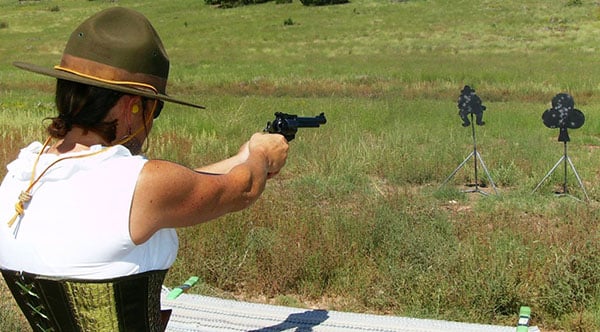
And, if all the above wasn’t enough competitive target shooting is yet another area where the Ruger Blackhawks really shine. Many metallic silhouette shooting competitors will use nothing but the 10-1/2” .44 Mag Super Blackhawk in competition. In the world of Cowboy Action Shooting, the Old Model 3-screw Blackhawk flattops have achieved a cult-like status, and the smooth action and excellent accuracy of the New Model BH makes it a popular choice with Single Action Shooting Society (SASS) competitors. Even the top dog in the SASS world – the Ruger Vaquero introduced in 1993 – is a Blackhawk derivative (or mutant!). This popular SA revolver was redesigned in 2004 and scaled down from the large to the medium frame, just like the original 1955 Blackhawk, but with a top strap slightly rounded front and rear like the Colt SAA. The Ruger Vaquero is so popular among Cowboy Action competitors that it is often called “the gun that won the New West.” Other differences from the Blackhawk include a spring loaded cylinder index button that facilitates quick loading by perfectly aligning the cylinder chambers with the loading gate, a crisp breaking, lighter pulling trigger and fixed sights – a rounded front blade and square notch rear.
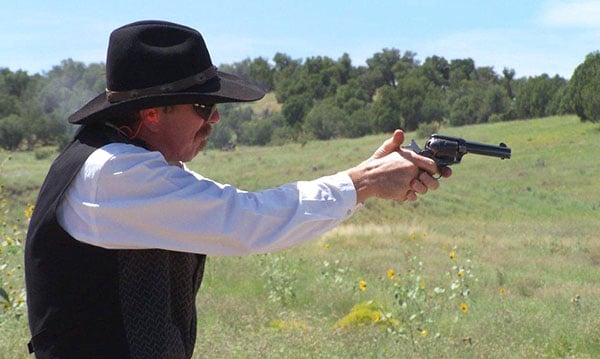
UNcomplimentary Adjectives
Creepy
This sounds like a child’s reference to an 8-legged insect, but it’s actually trigger critique. Ruger has never been known for great triggers, and Blackhawk triggers typically have some degree of creep. This can easily be corrected by a competent gunsmith – usually by shaving down the hammer/sear step – however, Ruger does not authorize trigger alterations, so this could void the warranty on a new gun.
Bulky
Ever since the New Model Blackhawk was introduced in 1973, people have complained that the large frame is bulky and unnecessary, and this may be valid criticism for the .357 Magnum caliber in my opinion. Others claim that the bulkiness hinders accuracy, but I think this is pure hogwash. My buddy’s wife is tiny at 5’2” tall and about 100 lbs. and trust me, you don’t want to challenge Mrs. Smith’s ability to shoot her New Model .357 Blackhawks accurately! Ruger brought the medium sized flattop frame back for a limited run of the 50th Anniversary Blackhawk in 2005, and they sold out quickly. And, firearms distributor Lipsey’s later convinced Ruger to introduce a .44 Special New Model on the same mid-size frame, which is currently available in the Ruger catalogue.
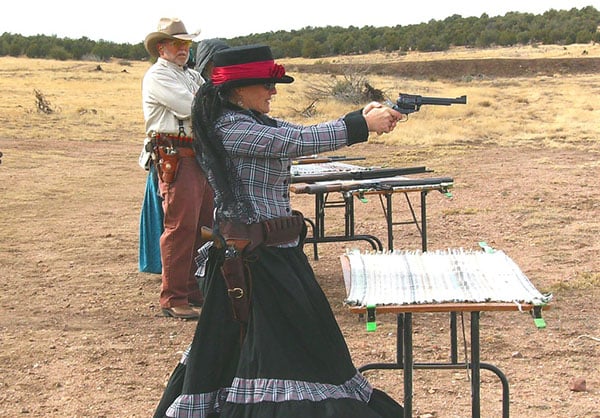
Someday we may see a few more medium-frame Blackhawks but for now, what’s a little bulk among friends? Not much when considering the always accurate, strongest, safest and most durable revolver ever made. A gun that never fails, and never breaks… the Ruger Blackhawk Single-Action Revolver.


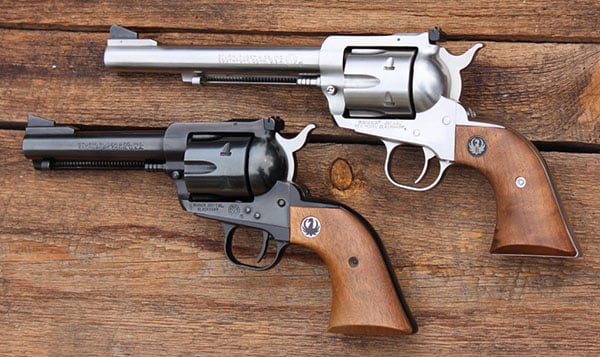
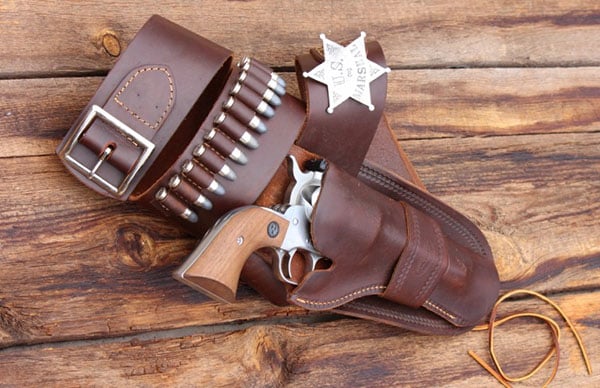
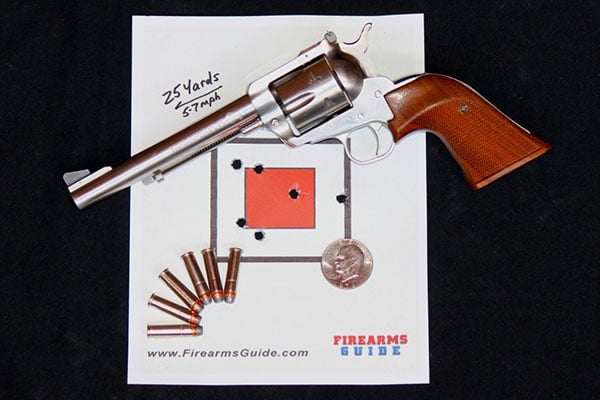
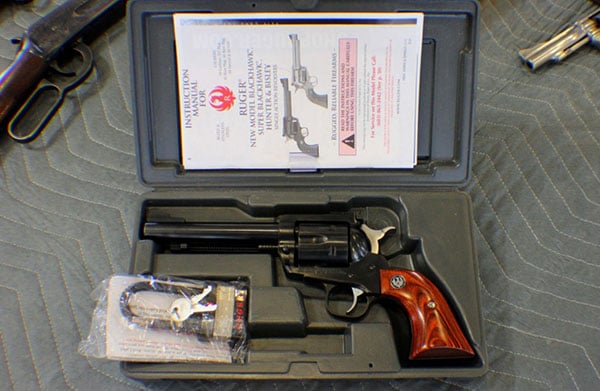
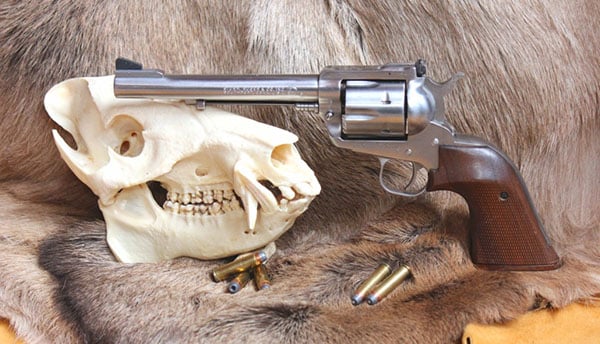



Comments (2)
Tony Martins | The Blog of the Gritr Sports Storesays:
June 23, 2015 at 2:07 pm[…] Ruger Blackhawk: Versatility And Durability In The Spirit Of The Old West […]
Amory McKeeversays:
July 2, 2016 at 12:24 pmGreat read, just recently got myself a .357 NMB with the 4.6″ barrel in stainless. Strength, beauty, and power all in one.
Dmansays:
July 30, 2016 at 11:16 pmThere is very little or no creep in the newer manufactured Blackhawks, the older ones were a bit worse, but still nothing to get in a twist over. It is pretty common in revolvers. The only shooters that would complain are those that have never shot a revolver before in their life. Ruger Blackhawks are the best guns for pistol hunting. They are still very popular because of this, if not for hunters, it may have been forgotten a long time ago. What is the most amazing is how widely it is still used and it being single action. It todays world of extended mags and semi-auto pistols, the Blackhawk is the grandpaw of the bunch, even though the internal design (from the mid 70s) is actually fairly new for any gun. If Sam Colt were still alive and opened up a Ruger New Model Super Blackhawk to look at the internals, he would be absolutely lost. The guts don’t look anything like any Colt SA. They are more complicated to work on and it is always best to send it to Ruger, but as the article says, they very very rarely, if ever, malfunction. I was stupid and sold mine many years ago when it had been neglected for a while and I was tight on money. I have always regretted it.
This article just helped Ruger sell yet another Super Blackhawk because after reading this, I just put down a deposit at my local gun shop for a fresh from the Ruger factory New Model Super Blackhawk .44 magnum, in brilliant Stainless Steel with the legendary Ruger Rose Wood grips! It sure is a beauty and I can’t wait to take her to the range. Gonna try the 25 yard then move to the 50 yard section with the big boys with this baby! This one is never seeing the inside of a pawn shop.